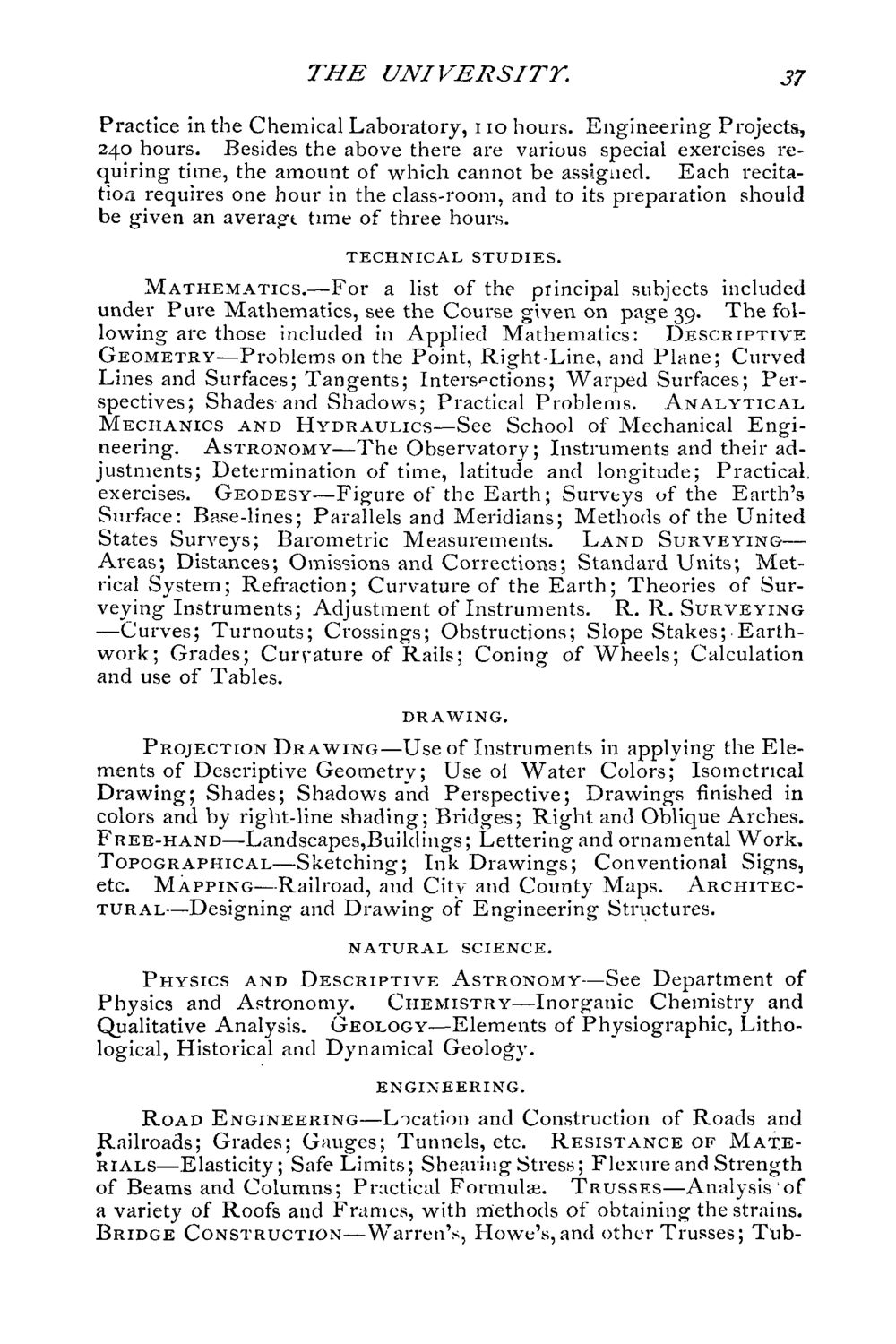Caption: Course Catalog - 1875-1876
This is a reduced-resolution page image for fast online browsing.

EXTRACTED TEXT FROM PAGE:
THE UNIVERSITY. 37 Practice in the Chemical Laboratory, 110 hours. Engineering Projects, 240 hours. Besides the above there are various special exercises requiring time, the amount of which cannot be assigned. Each recitatioa requires one hour in the class-room, and to its preparation should be given an averagt time of three hours. TECHNICAL STUDIES. MATHEMATICS.—For a list of the principal subjects included under Pure Mathematics, see the Course given on page 39. The following are those included in Applied Mathematics: DESCRIPTIVE GEOMETRY—Problems on the Point, Right-Line, and Plane; Curved Lines and Surfaces; Tangents; Intersections; Warped Surfaces; Perspectives; Shades and Shadows; Practical Problems. ANALYTICAL MECHANICS AND HYDRAULICS—See School of Mechanical Engineering. ASTRONOMY—The Observatory; Instruments and their adjustments; Determination of time, latitude and longitude; Practical, exercises. GEODESY—Figure of the Earth; Surveys of the Earth's Surface: Base-lines; Parallels and Meridians; Methods of the United States Surveys; Barometric Measurements. LAND SURVEYING— Areas; Distances; Omissions and Corrections; Standard Units; Metrical System; Refraction; Curvature of the Earth; Theories of Surveying Instruments; Adjustment of Instruments. R. R. SURVEYING —Curves; Turnouts; Crossings; Obstructions; Slope Stakes; Earthwork; Grades; Curvature of Rails; Coning of Wheels; Calculation and use of Tables. DRAWING. PROJECTION DRAWING—Use of Instruments in applying the Elements of Descriptive Geometry; Use ol Water Colors; Isometrical Drawing; Shades; Shadows and Perspective; Drawings finished in colors and by right-line shading; Bridges; Right and Oblique Arches. FREE-HAND—Landscapes,Buildings; Lettering and ornamental Work, TOPOGRAPHICAL—Sketching; Ink Drawings; Conventional Signs, etc. MAPPING—Railroad, and City and Count}' Maps. ARCHITECTURAL—Designing and Drawing of Engineering Structures. NATURAL SCIENCE. ASTRONOMY—See Department of Physics and Astronomy. CHEMISTRY—Inorganic Chemistry and Qualitative Analysis. GEOLOGY—Elements of Physiographic, Lithological, Historical and Dynamical Geology. PHYSICS AND DESCRIPTIVE ENGINEERING. ROAD ENGINEERING—Location and Construction of Roads and Railroads; Grades; Gauges; Tunnels, etc. RESISTANCE OF M A T E RIALS—Elasticity; Safe Limits; Shearing Stress; Flexure and Strength of Beams and Columns; Practical Formulae. TRUSSES—Analysis of a variety of Roofs and Frames, with methods of obtaining the strains. BRIDGE CONSTRUCTION—Warren's, Howe's,and other Trusses; Tub-
|